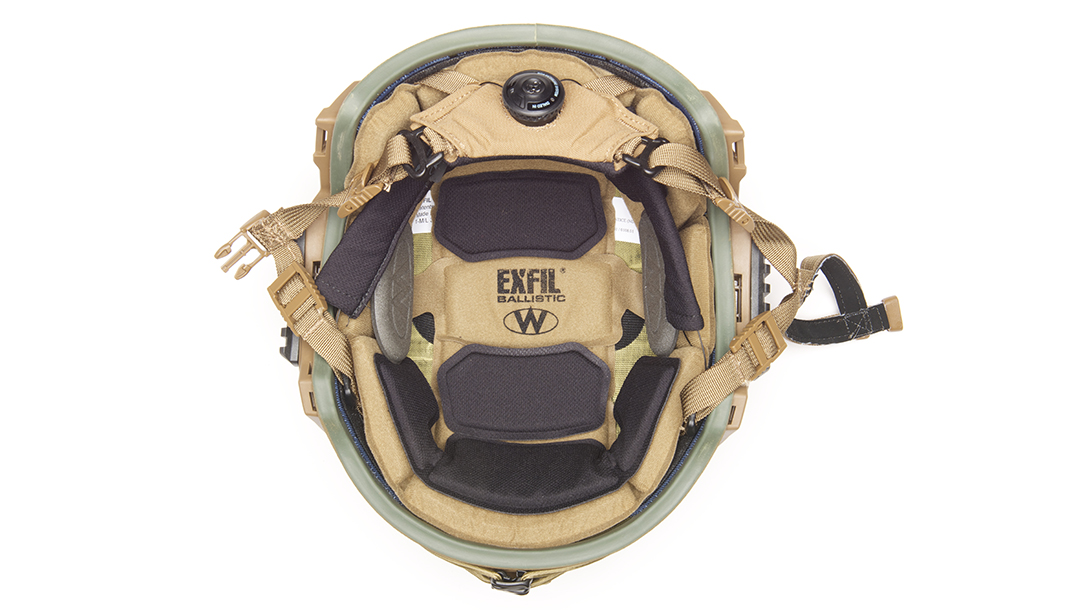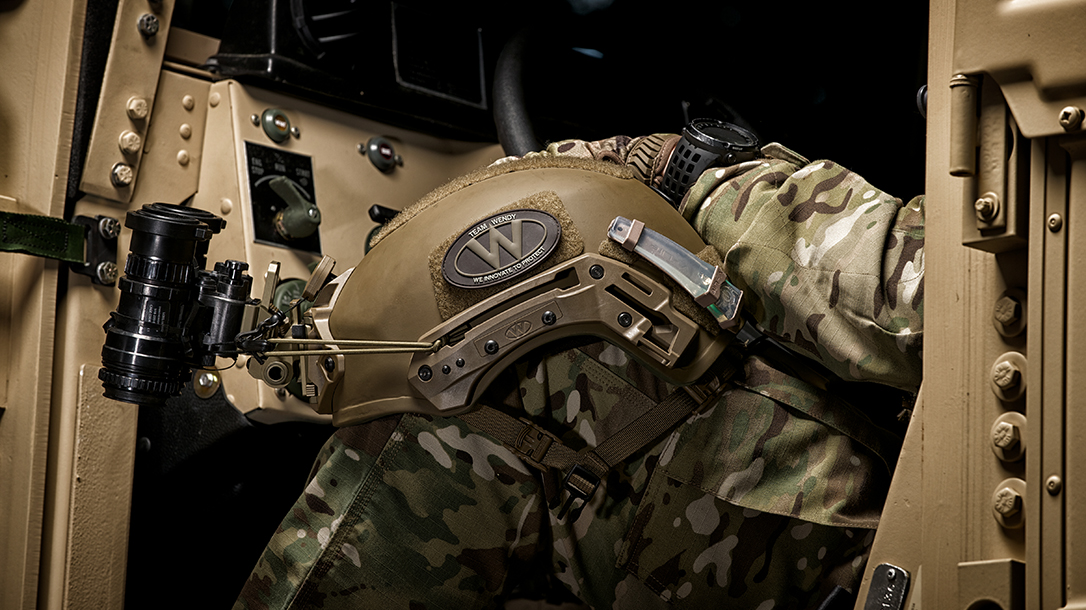The phrase “game changer” gets overused in a lot of mediums. However, when it comes to Team Wendy’s focus on preventing traumatic brain injury, its helmets truly are game changers.
Jump School
When I went through the U.S. Army jump school in the 1980s, we were issued classic two-part steel pot helmets. My roster number, C174, was stenciled across the front, and my copy looked like it had been in service since the American Revolution. I walked to the PX and bought myself a new leather sweatband because the version already in my high-mileage lid likely harbored disease.
Advertisement — Continue Reading Below
These were the same basic armored helmets that had carried our forefathers through World War II. The liner was made from some kind of synthetic material and was both lightweight and removable. The heavy bit was pressed from manganese steel and could be suspended over a fire as a cooking pot in a pinch.
I thought we were high speed because, unlike the same helmet I wore when I was not jumping out of airplanes, this one had a stiff foam pad sticking out the back to nominally protect the nape of the neck. On our first jump, one unfortunate member of my stick had his helmet ripped away as soon as he leapt into the prop wash. Thankfully no one was killed when the dislodged lid subsequently bounced into the drop zone below. With kit like that, it’s a wonder any of us survived.
The Processor
The human brain is the most complex contrivance in the known universe. The CPU on the latest F-35 multirole fighter plane pales in comparison to the phenomenal computational capabilities of the fingertip-sized mind of the squirrel that raids your wife’s bird feeder. Not only can we do precious little to fix a brain when it gets broken, but we don’t really even understand it terribly well.
Advertisement — Continue Reading Below
Humans have the largest brains relative to their body size of any known animal. A typical human brain weighs about 3.33 pounds and makes up around two percent of a typical person’s body weight. A human brain sports around 86 billion neurons that form via their axons and dendrites literally trillions of connections (that’s 12 zeroes). To claim that we can even begin to comprehend the engineering elegance behind this most remarkable of computers is the apex of farce.
To maximize the number of neurons per unit volume, the brain is designed with gyri and sulci; these are the variegated wiggles and valleys that characterize the unique surface of the brains of complex organisms. Intelligent animals like chimpanzees and dolphins have lots of these hills and valleys. Less intelligent creatures like mice, Socialists and gun-control advocates have smooth brains.
For all of its literally breathtaking complexity, the human brain, being comprised predominantly of fat, remains remarkably fragile. The skull is a superbly designed armored carapace that helps protect this delicate instrument from variegated mischief. However, as we humans push the boundaries of exploration, sports and combat, we find ourselves in desperate need of yet better protection for this most sensitive of mechanisms.
Advertisement — Continue Reading Below
The Problem
Now well into the Information Age, science has changed most every aspect of armed combat. The scourge of the IED, combined with the unique rigors of a protracted unconventional war across an asymmetrical battlefield, conspires to offer new and unique challenges for our men and women serving downrange. These travails have brought the power of science to bear on the thorny problem of protecting the remarkable computer that sits astride your shoulders from the sundry malice specifically contrived to destroy it.
Where previously we just dropped a bit of manganese steel atop our otherwise unadorned domes and called it good, nowadays a great deal of thought and treasure has gone into maximizing the brain’s defenses against shock, pressure and blunt-force trauma.
Advertisement — Continue Reading Below
The challenge is timeless and the stakes astronomical. While lots of folks have tackled this prickly problem, none have pushed the boundaries so far as Team Wendy. To understand the passion Team Wendy has for mitigating brain injuries, you need to know the remarkable narrative that drives its zeal.
The Backstory on Team Wendy
Team Wendy draws its name from a young lady named Wendy Moore. Her father, Dan, tragically lost his daughter to a traumatic brain injury stemming from a skiing accident in the 1990s.
Where many of us dads would have allowed an immeasurable tragedy of this sort to destroy us, Dan translated his loss into a superhuman drive to protect others from a similar fate. That singular event drove Dan Moore to found Team Wendy with the mission of producing the finest protective headgear the world has ever seen.
Advertisement — Continue Reading Below
Evolution
The company began in 1997 with ski helmets. As the science of helmet design evolved, Team Wendy delved into high-tech helmets for law enforcement, military, and search and rescue applications.
Nowadays, Team Wendy’s mandate is to research, develop, design and deliver the most innovative, protective and impact-mitigating products and technologies in the world while simultaneously researching the causes and prevention of traumatic brain injury (TBI).
Out of one father’s incalculable loss came new technologies that have ultimately saved countless lives already.
Advertisement — Continue Reading Below
Zorbium
The company produces helmets for a remarkably long list of applications, but those helmets share a common beating heart. Team Wendy’s most notable developmental accomplishment to date is a patented impact-mitigating foam called Zorbium. First developed for ski and multisport helmets, this material has found a home in tactical and search and rescue helmets as well.
Zorbium provides a significant increase in blunt impact protection and has been incorporated into the standard-issue helmet pads of both the U.S. Army and Marine Corps since 2005. Zorbium dropped the peak “G” threshold for padded combat helmets by 50 percent over previous designs. That simply means it does a much better job of protecting your head.
Team Wendy does its own in-house development of material technologies, as well as morphological design. New helmets begin as brainstorming concepts before advancing through refinement, testing and ultimately practical validation. Team Wendy’s unique grasp of material development, combined with end-user requirements, has produced some of its most successful products.
Advertisement — Continue Reading Below
Team Wendy prides itself on being large enough to meet the demands of government users while remaining sufficiently agile to respond to the rapidly evolving needs of its customers. The company’s production processes include foam production, radio frequency sealing, fabric cutting, sewing and final helmet assembly. The folks at Team Wendy fully appreciate the holy nature of their mission; subsequently, they build world-class quality into every helmet they produce.
GO Gear
Team Wendy’s flagship product is the EXFIL line of helmets. Available in four primary configurations, all EXFIL helmets are designed to be comfortable, lightweight and protective. The specific models in this line are the EXFIL Carbon, the EXFIL LTP (Lightweight Tactical Polymer), the EXFIL SAR (Search and Rescue) and the EXFIL Ballistic.
Advertisement — Continue Reading Below
EXFIL Features
The entire EXFIL line shares a common array of features. The primary differentiators between the basic configurations are the performance specifications. All helmets in the line conform to the military blunt-impact standards. The Carbon, LTP and SAR helmets are all non-ballistic, meaning they are not designed to resist bullets and shrapnel. The LTP meets the EN 1385 standard for whitewater helmets. The SAR meets commonly accepted mountaineering and industrial standards. The EXFIL Ballistic meets accepted ballistic benchmarks. As you can imagine, the more rugged the material, the heavier the helmet.
The EXFIL Ballistic helmet is available with a robust ballistic-resistant shell. The lightweight, non-ballistic EXFIL Carbon synthetic carbon- fiber helmet is offered for modestly violent applications. The LTP bump shell is rated against mild impacts, as is the dedicated SAR variant. In these four configurations, the common EXFIL design offers a range of protection from high-velocity bullets down to the sorts of bumps and scrapes you might acquire during basic adventurous activities. By utilizing a common suspension and retention system along with a communal family of external accessories, a singular helmet design is optimizable for most any conceivable application.
EXFIL helmets employ an innovative boltless CAM FIT retention system that is easily adjustable and maximizes user comfort. This unique system conforms to various head shapes to ensure stability and security. This retention system also allows one-handed adjustment for a proper fit. A Boa closure system keeps everything snug.
Liners
Moveable comfort pads optimize the Zorbium foam liner. These pads are available in two thicknesses to conform to varying anatomy. This liner accommodates an overhead communications headband via a removable center pad while still protecting against violent impacts. This same system has been combat proven in the standard Advanced Combat Helmet (ACH) Zorbium Action Pad (ZAP) system used in U.S. military helmets.
The U.S. Army Natick Soldier RD&E Center HEaDS-UP Program originally designed an alternative thermoplastic urethane (TPU) Hybrid liner. These TPU liners are optimized for impact protection. The resulting design maximizes airflow and ventilation by creating a standoff area between the operator’s head and the helmet shell. This particular liner option is only available on the EXFIL Carbon. Team Wendy recently updated the design to be identical to the REVOLVE liner system.
Mounting
The exterior of the EXFIL Ballistic, Carbon and LTP shells sports a Rail 2.0 mounting system, as well as T-slots for incorporating accessories. There is also a pair of Magpul MOE Picatinny-style rails for any imaginable accessory bling. A lanyard-compatible Wilcox shroud accommodates night-vision systems.
On the Horizon
Team Wendy also has some exciting new products in the pipeline. These include an armored mandible attachment that affixes to the helmet’s organic rails. This accessory will provide ballistic protection for the face and jaw as well as applique armor that provides protection against 7.62x39mm M43 rifle rounds. The company will also soon be offering side armor components that provide as much coverage as the current ACH combat helmet. A rail-mounted ballistic visor is in the works as well.
The Passion
The world has indeed come a long way since I first stood quivering in the door of a thundering C-130 underneath my WWII-era manganese steel combat helmet so many years ago. Meanwhile, traumatic brain injury continues to take a toll on our brave warriors serving downrange. However, new mine-resistant, blast-resistant vehicles combined with such high-tech stuff as Zorbium and the Team Wendy EXFIL helmets serves to mitigate its effects.
One father’s tragic loss has spawned new technologies that are in the field, on the front lines and atop the heads of lifesaving first responders as I type these words. Team Wendy is a unique company with a unique story. The passion of its mission transforms its basic business into a much higher calling.
For more information, visit TeamWendy.com.
This story is from the spring 2018 issue of Ballistic Magazine. Grab your copy at OutdoorGroupStore.com.



























